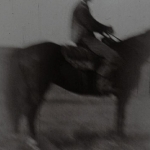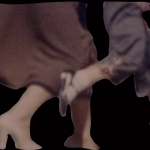Premiered November 11, 2012 at the Egyptian Theater in Hollywood.
Curated by Jaimie Baron, Lauren Berliner, and Greg Cohen. Sponsored by Los Angeles Filmforum.
“The appropriation of mainstream/commercial culture by artists is nothing new — you can trace it back through Negativland, Craig Baldwin and other post–hip-hop culture jammers of the ’80s and ’90s; Guy Debord and the Situationists of the ’60s; Duchamp and the Dadaists; and probably further. But in the era of the omnipresent YouTube mash-up, it might be harder than ever to find work that approaches appropriation as an art, with or without the subversive designs of the original recombine innovators.
That’s where the Festival of (In)appropriation comes in. The 2012 installment of the fourth annual festival’s typically varied program includes fragmentary narratives crafted from home movies (Saskatchewan and Ghosts of Yesterday, as different as can be but both haunting); recontextualizations of footage from North by Northwest (Cropduster Octet) and the Star Wars prequels (Machine Language); a riff on the relationship between analog video technology and Felix the Cat (Cat Scannd); and much more. There’s not a mere one-liner in the pack, but highlights include Scarlet, a gorgeous, moving painting–style collage tribute to Jane Fonda; Night Hunter, Stacey Steers’ animated blending of images of silent starlet Lillian Gish with precinematic engravings, to create a melancholic dream/nightmare evocation of female anxiety; and Retrocognition, a weird and unsettling stew of postwar radio dramas and photo collage, bringing to life the latent rage of midcentury American pop culture.”
—Karina Longworth, LA Weekly, November 8, 2012
◊ ◊ ◊
 Cropduster Octet by Gregg Biermann (HD video, color, sound, USA, 2011, 5:30)
Cropduster Octet by Gregg Biermann (HD video, color, sound, USA, 2011, 5:30)
In Cropduster Octet, the iconic “crop duster” sequence from Hitchcock’s North by Northwest in which Cary Grant is repeatedly attacked by a small airplane swooping from the sky is deconstructed into eight horizontal bands, each of which is slightly out of synch with the next. As the scene (and, in particular, Grant’s body) is continuously deconstructed, the patterns of action are refigured and intensified, culminating in a crescendo of convergence.
◊ ◊ ◊
 Saskatchewan by Richard Wiebe (16mm on digital video, black/white, sound Canada, 2012, 16:00)
Saskatchewan by Richard Wiebe (16mm on digital video, black/white, sound Canada, 2012, 16:00)
Using 16mm footage and Edison Voicewriter recordings created by family members many years before, filmmaker Richard Wiebe – whose family came from Saskatchewan but who grew up in North Carolina – paints a portrait of rural culture in the plains of Canada in the 1940s. Wiebe’s father, grandparents, aunt, uncle and others now gone populate, along with trains and cattle, the stark but beautiful landscape.
◊ ◊ ◊
 I For NDN by Clint Enns and Darryl Nepinak (digital video, color, sound, Canada, 2011, 1:34)
I For NDN by Clint Enns and Darryl Nepinak (digital video, color, sound, Canada, 2011, 1:34)
In this short, humorous piece that comments on the implicit assumptions embedded in our most basic education, Clint Enns and Darryl Nepinak appropriate footage from an educational program designed to teach children their vowels – and an unsuspecting character finds himself serving as an example.
◊ ◊ ◊
 Scarlet by Sharon A. Mooney (digital video, color, sound, USA, 2012, 4:44)
Scarlet by Sharon A. Mooney (digital video, color, sound, USA, 2012, 4:44)
Audio samples culled from Jane Fonda films from the 1960s and ’70s are woven together over lenticular images of sexpot aliens, which are physically titled to transform one image to the other. The meditative soundtrack combined with snippets of dialogue generates a hypnotic atmosphere in which the strange visual transformations seem to reflect our distorted perceptions of ourselves.
◊ ◊ ◊
 Cat Scannd by Michael Guccione (digital video, color, sound, USA, 2010, 3:27)
Cat Scannd by Michael Guccione (digital video, color, sound, USA, 2010, 3:27)
Guccione became interested in how a TV image is built, namely the NTSC standard, a series of scanned lines on alternating fields of 262 ½ lines resulting in a composite of 525 lines of picture signal. He wanted to slow down what took place in nanoseconds to a perceivable movie experience without having to be literal, and he came across one of the first televised images scanned mechanically during the late ’20s by RCA which was cartoon character Felix the Cat made up of just 60 lines. The early experimenters placed a 13” paper mache effigy of Felix on a turntable and aimed the camera point blank at their smiling model as they toiled at making television a viable visual medium. Emerging from this background is an animated piece interfacing homemade constructions of the 1959 Felix cartoons with a layman’s take on television’s scanned lines and added pinches of Hans Richter, Paul Hindemith, Tor Johnson and others.
◊ ◊ ◊
Night Hunter  by Stacey Steers (35mm on HD video, black/white & color, USA, 2010, 15:30)
by Stacey Steers (35mm on HD video, black/white & color, USA, 2010, 15:30)
Meticulously crafted from approximately 4000 handmade collages and incorporating images of Lillian Gish taken from silent-era live-action cinema, Night Hunter evokes a disquieting dreamscape drawn from allegory, myth, and archetypes. Images from four silent-era films featuring the actress Lillian Gish are combined with 18th and 19th century engravings to create rich, timeless, imaginative environments. Transitions, both biological and metaphorical, are central themes. In some instances Gish is cut out of specific scenes and reconfigured in collage environments, while collage materials are applied directly to printed film frames in others. The subsequent fluidity of character becomes a critical element in the texture of the film and the identity of the principal character. Night Hunter was shot on an Oxberry animation stand in 35mm using a Mitchell camera. Music and sound by Larry Polansky.
◊ ◊ ◊
 Machine Language by Robert Todd (digital video, color, sound, USA, 2012, 5:30)
Machine Language by Robert Todd (digital video, color, sound, USA, 2012, 5:30)
In Part 3 of Robert Todd’s “Future Perfect” series, which highlights the digital grammar of Star Wars Episodes 1-3, robots speak to one another in series of blips and beeps that – isolated from their narrative contexts and human dialogue – become a mysterious poetry that suggests communication but also refuses to cohere into comprehension.
◊ ◊ ◊
La Salle Hotel by Scott Fitzpatrick (35mm on digital video, color, sound, Canada, 2011, 2:00)
by Scott Fitzpatrick (35mm on digital video, color, sound, Canada, 2011, 2:00)
An abstracted depiction of the 1946 fire at the La Salle Hotel in Chicago, Illinois, where even the frame itself threatens to collapse. Archival footage is broken down digitally, colourized, and laser-printed directly onto 35mm film.
◊ ◊ ◊
Revving Motors, Spinning Wheels (Action Painting)  by Jeremy Rotsztain (digital video, color, sound, USA, 2011 4:05)
by Jeremy Rotsztain (digital video, color, sound, USA, 2011 4:05)
Revving Motors, Spinning Wheels (Action Painting) is an animated digital painting composed using cinematic gestures from Hollywood action films. High-octane moments from car chases — humming motors, screeching turns, and crashes — are digitally extracted and transformed into colorful abstract expressionist gestures in the tradition of Jackson Pollock. The Action Painting series brings together the adrenalin-filled culture of action cinema and the formalist canon of modernist painting; it follows the recent cultural trend of aestheticizing violence and pushes it to an exaggerated level.
◊ ◊ ◊

Forsaken by Heidi Phillips (16mm to digital video, color, sound, Canada, 2012, 4:30)
In Forsaken, Phillips abstracts images selected from found footage using contact printing, hand tinting, and toning. Muscle men, machinery, and building climbers become foreboding figures in this darkly apocalyptic film.
◊ ◊ ◊
 Youtopia by Danial Nord (digital video, color, sound, USA, 2011, 2:29)
Youtopia by Danial Nord (digital video, color, sound, USA, 2011, 2:29)
Danial Nord continues his indictment of contemporary culture by manipulating the tools of mass communication. In his digital video Youtopia, the artist captures hyperlinked reality to poke fun at the curatorial process in the age of misinformation. After receiving an email with a link to the New York Times article titled: “Guggenheim and YouTube Seek Budding Video Artists,” Nord created virtual assistants to investigate. Their automated inquiries, skewed by database hierarchies and software glitches, produce convoluted associations and misguided conclusions. The search results, texts, and screen-grabs are ‘real’, but the electronic helpers have ulterior motives, blurring boundaries between artificial intelligence and the human psyche. Youtopia highlights the general state of affairs in our quick-to-click culture.
◊ ◊ ◊
 Ghost of Yesterday by Tony Gault (digital video, color, sound, USA, 2012, 5:30)
Ghost of Yesterday by Tony Gault (digital video, color, sound, USA, 2012, 5:30)
This collage of rotoscoped home movies is inspired by childhood memories of religion and altered consciousness. The film explores our collective abandonment of analog imagery and is Gault’s personal attempt to reconcile with digital imagery.
◊ ◊ ◊
Retrocognition  by Eric Patrick (digital video, color, sound, USA, 2012, 17:37)
by Eric Patrick (digital video, color, sound, USA, 2012, 17:37)
An animated collage of photographs and audio fragments from WWII era radio dramas critique the classic American televisual nuclear family.
◊ ◊ ◊
Special thanks to Adam Hyman.